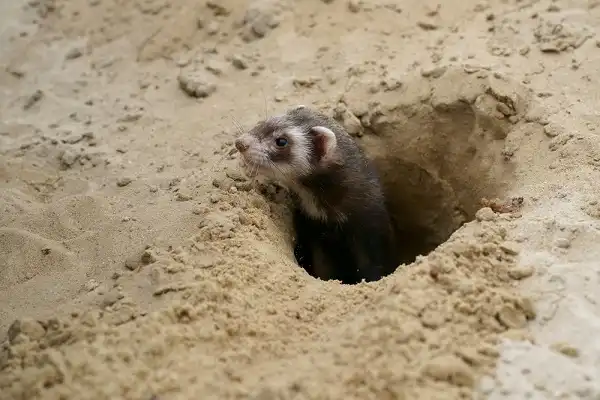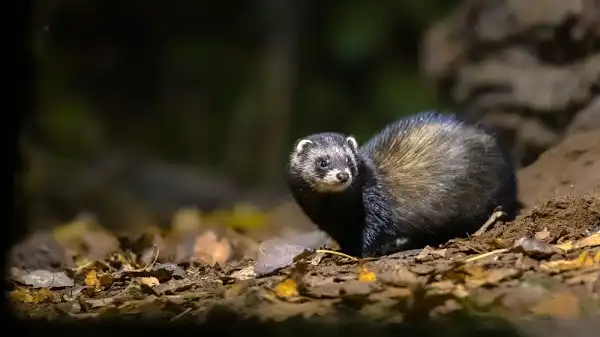Do you know what a European polecat is? If not, now is the time to find out! The European polecat or Mustela putorius, as it’s also known, is a fascinating mammal belonging to the family of predatory carnivores. This fierce but small animal has many interesting features that make it unique and enamoring. In this blog post, we will explore the natural behavior and habits of the European polecat so you can learn all about this intriguing species.

European Polecat Description
The European Polecat, also known by its scientific name Mustela putorius, is a small but fierce mammal that belongs to the family of carnivorous creatures. It has a slender body and a striking, ferret-like appearance. The fur of the European polecat is dense and sleek, varying in color from dark brown to nearly black, with a white or yellow underbelly. One of the distinguishing characteristics of this species is its distinctive mask-like facial markings, which are comprised of black fur around its eyes, nose, and mouth. While the European polecat is found throughout Europe and parts of Asia, it has faced numerous threats over the years, including habitat loss and hunting for its valuable fur. However, conservation efforts have been successful in stabilizing populations in some areas. Overall, the European polecat is a fascinating and distinctive creature, with unique physical and behavioral characteristics that make it stand out in the animal kingdom.
European Polecat Habitat
The European polecat has a wide range of habitat preferences, ranging from dense forests to open fields and meadows. However, it tends to avoid areas inhabited by humans, and its population has been impacted by human development and expansion. In general, the European polecat prefers habitats with ample cover and prey, such as dense brush, hedgerows, and forests. It also requires a source of water for drinking and bathing. The European polecat is found throughout Europe and parts of Asia, but its distribution has been impacted by historical hunting and trapping for its fur. Conservation efforts have been successful as the planting of hedgerows and the creation of wildlife corridors, has been a key component of these efforts. Overall, the European polecat is adaptable to a range of habitats but requires access to food, water, and cover to thrive. Despite historical threats to its population, conservation efforts have demonstrated the ability to stabilize and even increase the populations of this fascinating and unique mammal.
European Polecat Diet
The European polecat is known for its versatile and diverse diet, which includes a range of small mammals, birds, reptiles, and insects. As a carnivorous predator, the European polecat is an adept hunter, using its agility and quick reflexes to capture prey. Its diet consists primarily of rodents, such as mice, voles, and rats, but it also preys on larger mammals such as rabbits and hares. In addition to small mammals, the European polecat will also consume birds, reptiles, and insects. It has been observed eating everything from small songbirds to larger game birds, such as pheasants and partridges, as well as lizards, snakes, and frogs. Like many predators, the European polecat is opportunistic and will adapt its diet to the availability of prey in its environment. The diet of the European polecat also varies seasonally. In winter, when small mammals are less abundant, the polecat may rely more heavily on birds and other prey. During the summer months, when small mammals are more plentiful, the polecat may focus more on hunting them.

European Polecat Size
The European polecat, also known as Mustela putorius, is a medium-sized mammal that measures between 30-50 centimeters in length and weighs between 0.6-1.6 kilograms. Males are typically larger and heavier than females. The polecat has a long and slender body, a short tail, and sharp claws that aid in hunting. This carnivorous animal has sharp teeth, which are used for tearing meat, and a keen sense of smell, which helps it track prey. Its fur is dark brown to black in color, with a white patch under the throat and on the feet. This distinctive coloration helps the polecat blend in with its surroundings and avoid predators. While the European polecat is a relatively small animal, it is larger than many of its close relatives, including the stoat and the weasel. Its size and physical characteristics vary depending on its geographic location and subspecies. For example, the Russian polecat, which is found in Russia and parts of China, is larger and more robust than the European polecat.
European Polecat Lifespan
The lifespan of the European polecat, also known as Mustela putorius, can vary depending on a variety of factors such as food availability, habitat quality, and predation. In the wild, the average lifespan of a European polecat ranges from 3 to 4 years, although some individuals have been known to live up to 8 years. During captivity, the lifespan of the European polecat can increase dramatically, with some individuals living up to 10 years. The reason for this increase in lifespan is likely due to the improved quality of life and the ability to receive proper medical care in captivity. The lifespan of the European polecat can also vary depending on its sex, with females typically living slightly longer than males. Additionally, the lifespan of the European polecat may be affected by human activities such as habitat loss and hunting. Conservation efforts aimed at protecting the European polecat and its habitat have shown promise in increasing the lifespan of this unique mammal. By promoting the creation of wildlife corridors and the planting of hedgerows, populations of the European polecat have been stabilized and even increased in certain areas.
European Polecat Behavior
The European polecat, also known as Mustela putorius, is a fascinating mammal with intricate behavioral characteristics. These adaptable predators are nocturnal and highly territorial, using scent marking as a means of establishing their area of control. They are solitary animals that avoid contact with other individuals of the same species, except during the mating season. During this time, males and females will come together to mate, after which the female will give birth to a litter of kits. While generally solitary animals, the European polecat is not entirely averse to interaction with other species. They have been known to form symbiotic relationships with red foxes, sharing dens and hunting territories. Additionally, they may prey on small domestic animals such as rabbits and chickens, which can lead to conflict with humans.

European Polecat Speed
The European polecat, while not known for its speed, is a highly agile predator with impressive hunting skills. These creatures are capable of reaching speeds of up to 30 miles per hour, making them relatively speedy runners. However, their true hunting prowess lies in their incredible agility and hunting strategies. In addition to their speed and hunting skills, European polecats are also known for their remarkable resilience and adaptability. European polecats may not be the fastest predators in the animal kingdom, but their agility and hunting skills make them highly effective hunters. Their ability to adapt to changing conditions has allowed them to thrive in a variety of habitats, and conservation efforts are crucial to their survival.
European Polecat Hunting
The European polecat is a highly adaptive predator with impressive hunting skills. While not known for its speed. However, its true hunting prowess lies in its incredible agility, sharp teeth, and claws. The European polecat is a solitary animal, using its keen sense of smell to track prey in its natural habitat. Its hunting strategies vary, with the animal chasing down small mammals, birds, and reptiles. Its ability to dig, climb, and swim provides the polecat with a range of potential hunting strategies. Territorial marking is an important aspect of the polecat’s hunting toolkit. Polecats leave scent marks to indicate their territory and to warn off other predators. They are known to be expert tree climbers, able to pursue prey into the treetops. Polecats also use their agility to hunt burrowing animals, which they dig out of their holes with ease. Conservation efforts are important in protecting the European polecat, and conservationists have shown promise in ensuring the animal’s continued existence for years to come. By protecting their habitats and raising awareness, we can ensure that these adaptable predators continue to thrive in the wild.
European Polecat Reproduction
In addition to its impressive hunting abilities, the European polecat is also a highly successful reproducer. Female polecats typically give birth twice a year, producing litters of 5 or more kittens. The mother will nurse and care for her young until they reach independence at around 3 months old. Once independent, the kittens disperse from their mothers’ territory in search of their own breeding ground. These juvenile polecats are capable of surviving on their own and can live up to seven years in the wild. European polecats are an important part of their natural ecosystems and play a vital role in maintaining ecological balance. The species faces several threats from humans, including habitat loss and hunting. Conservation efforts are essential for the protection of these animals and their continued survival in the wild. By taking action we can ensure that European polecats remain part of our fragile ecosystem for years to come.

Conclusion
European polecats are incredibly adaptable predators, with impressive hunting skills that enable them to thrive in a range of habitats. They use their agility and sharp teeth and claws to pursue prey, while their keen sense of smell allows them to track down small mammals, birds, and reptiles. Conservation efforts are essential for the protection of these animals and their continued survival in the wild. By taking action we can ensure that European polecats remain part of our fragile ecosystem for years to come. In conclusion, European polecats possess an impressive range of skills that make them effective hunters and adaptive survivors in diverse ecosystems. With proper conservation efforts, we can protect this unique species from habitat loss and hunting-related threats and help ensure its
Frequently Asked Question

